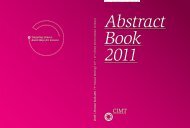Abstract Book 2010 - CIMT Annual Meeting
Abstract Book 2010 - CIMT Annual Meeting
Abstract Book 2010 - CIMT Annual Meeting
You also want an ePaper? Increase the reach of your titles
YUMPU automatically turns print PDFs into web optimized ePapers that Google loves.
092 Tomsitz | Tumor biology & interaction with the immune system<br />
Establishment of a pre-clinical NOD/LtSz-scid IL2Rgammac null<br />
(NSG) mouse model to evaluate immunotherapeutic strategies<br />
for acute myeloid leukemia (AML)<br />
Dirk Tomsitz 1 , Ariane Brunk 1 , Marion Nonn 1 , Alexander Hohberger 1 , Shamsul A. Khan 1 ,<br />
Eva Distler 1 , Matthias Theobald 1 , Wolfgang Herr 1 , Udo F. Hartwig 1<br />
1 Dept. of Medicine III - Hematology and Oncology, Johannes-Gutenberg-University Medical Center,<br />
Mainz, Germany<br />
Introduction: Acute myeloid leukemia (AML) is a<br />
cancer of the myeloid line of blood cells, characte-<br />
rized by the clonal expansion of immature mye-<br />
loblasts potentially initiating from rare leukemic<br />
stem cells. Xenotransplantation of human AML into<br />
immunodeficient mice is essential for establishing<br />
a preclinical model to i) assess the potency of modified<br />
donor lymphocyte grafts to induce immunotherapeutic<br />
graft-versus-leukemia (GVL)-reactivity<br />
and ii) to study the properties of leukemic stem<br />
cell biology. Here we report the successful engraftment<br />
of 8 out of 14 patient-derived, primary AML<br />
samples in NOD/LtSz-scid IL2Rgammacnull (NSG)<br />
mice within 2-12 weeks, with a mean of 0,2-40%<br />
human leukemic cells in the bone marrow (BM). In<br />
first studies, we also show the successful eradication<br />
of engrafted AML-blasts using AML-reactive,<br />
HLA-mismatched T lymphocytes.<br />
Methods: Mice were used unconditioned or irradiated<br />
with 150 cGy 4-16h prior to intravenous (i.v.)<br />
transfer of 5x104-1x107 primary AML cells. Engraftment<br />
kinetics and dose-dependencies were analyzed<br />
by means of clinicopathological criteria and<br />
flow cytometry. AML-reactive T cells were generated<br />
in a HLA-mismatched setting over 3 weeks from<br />
PBMCs isolated from buffy coats. One week after<br />
transplantation of 5x105 AML cells from patient<br />
MZ667, AML-bearing mice were i.v. injected with<br />
5x106 CD8+ leukemia-reactive T lymphocytes.<br />
Results: Stable AML-engraftment in NSG recipients<br />
was detected upon transplantation of 8 out of 14<br />
primary AML samples by determing the percentage<br />
of CD33+/CD45+ cells in blood, spleen and BM.<br />
Expression of Flt3 mutations appeared to promote<br />
engraftment of AML-samples. In addition to leukemic<br />
blasts, we frequently observed co-engraftment<br />
of human T cells present in the AML-graft, possib-<br />
ly facilitated due to irradiation of recipients. In 4<br />
cases, stable AML engraftment was inhibited by<br />
T cell outgrowth and induction of xenoreactivity.<br />
However, in general irradiation augmented the<br />
engraftment efficacy of AML. Thus, we attempted<br />
to circumvent T cell growth by a) depleting T cells<br />
from AML-samples using MACS-technology® or b)<br />
treating animals with immunosuppressiva such as<br />
Cyclosporin A, Mycophenolatemofetil and Tacrolimus.<br />
Immunomagnetic T cell depletion resulted in<br />
stable but decelerated AML engraftment without<br />
T cell outgrowth, whereas preliminary results indicated<br />
that treatment of transplanted mice with<br />
immunsuppressiva abrogate engraftment of both<br />
AML and T cells. Finally, we started to explore our<br />
model for investigating GVL-responses of AMLreactive<br />
human T cell lines generated by repetitive<br />
stimulation of healthy donor lymphocytes with<br />
AML blasts. In first studies using HLA-mismatched<br />
AML MZ667-reactive CD8+ T cells we could demonstrate<br />
that following adoptive transfer of T<br />
lymphocytes into AML MZ667 bearing mice, leukemic<br />
blasts could be completely eradicated, whereas<br />
in controls stable engraftment was detectable in the<br />
BM.<br />
Conclusions: These results suggest that NSG mice<br />
represent a valuable tool for the establishment of a<br />
preclinical AML model to evaluate the immunotherapeutic<br />
GVL-reactivity of ex vivo modified T cellgrafts<br />
as well as to analyze properties of leukemia<br />
stem cell biology.<br />
141



